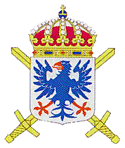

Copyright © Hans Högman 2019-05-20
Swedish Regiments of
the Allotment System -
Infantry (5)
Infantry Regiments:
1. Swedish Regiments -
Infantry (5)

Swedish name: Närke-Värmlands regemente
The regiment was first established in 1624 as the
Närke-Värmland Regiment. The Närke part of the
regiment was linked to the Allotment System in May
11th 1686 and the Värmland part in June 25th 1688.
The regiment was divided in 1812 into two new
regiments, The Närke Regiment (I21) and the
Värmland Regiment (I22).
The history of the Närke-Värmland Regiment goes
back to the "fänikor" that were raised in the
provinces of Värmland and Dalsland in the 16th
century.
In 1614, King Gustav II Adolf formed a
"landsregemente" - a Grand Regiment, from the
"fänikor" in the provinces of Värmland, Närke and
Södermanland. This grand regiment numbered 3600
soldiers.
In 1624 the Grand Regiment was split up into two
independent regiments, The Södermanland
Regiment and the Närke-Värmland Regiment.
As a result of the Constitution adopted in 1634 the
Army was reorganized. The Närke-Värmland
regiment was then referred to as the "19th Regiment".
The regiment was allotted had a total of 1674
"rotar".
Hence, the Regiment 1674 soldiers organized into
10 companies. All of the "rotar" were located within
the provinces of Närke and Värmland.
(474 "rotar" formed 3 companies in Närke and 1200
"rotar" formed 7 companies in Värmland).
Names of the Companies making up the
Regiment in 1682:
Närke companies; The Life Company, The Major's
Company and Örebro Company.
Värmland comapnies; The Lieutenant Colonel's
Company, Kristinehamns Company, Älvdals
Company, Karlstads Company, Jösse härads
Company, Näs Company (Näs härads company) and
Nordmarks Company.
Uniform before the standard uniform: Red coat
with blue cuffs (1675) and Red coat with white cuffs
(1676). The regiment received the standard uniform
(the blue and yellow Carolean uniform) in 1691.
Training camp: Between 1684 and 1817 Västra fältet
in Kristinehamn and in Sunne.
Companies before 1812, Närke-Värmland
Regiment:
1.
Life Company
2.
Lieutenant Colonel's Company
3.
Major’s Company
4.
Örebro Company
5.
Kristinehamns Company
6.
Jösse härads Company
7.
Älvdals Company
8.
Näs Company
9.
Karlstads Company
10.
Nordmarks Company
Training camp: From 1767 Sannahed, northern part.
Victorious Battle Campaigns (segernamn), Närke-
Värmland Regiment:
•
Fredriksodde
1657
•
Tåget över Bält
1658
•
Lund
1676
•
Landskrona
1677
•
Narva
1700
•
Düna
1701
•
Kliszow
1702
•
Fraustadt
1706
•
Malatitze
1708
•
Gadebusch
1712
See also: Campaigns of the Närke-Värmland
Regiment.
Rote numbers and rote names at Närke-Värmland
regiment prior to 1812
Swedish name: Närkes regemente, I21
The Närke Regiment was established when the
Närke-Värmland Regiment was divided in 1812.
In 1893 the regiment was merged with the Grenadier
Corps of the Life Regiment (Livregementets
grenadjärkår) and the new regiment received the
name the Life Regiment of Foot (Livregementet till
fot). The Närke soldiers formed the regiment's 2nd
battalion.
In 1904 the regiment received the name the Life
Regiment Grenadiers (Livregementets grenadjärer,
I3).
The regiment was disestablished in 1992. Today a
local defense district unit (försvarsområdesförband)
carry the same name.
The new Närke Regiment had 766 "rotar" in 1812
(474 in the county of Örebro and 292 in the eastern
parts of the county of Värmland).
The 292 rotar in eastern Värmland; in Visnum Härad,
Ölme Härad and Väse Härad (including a few rotar in
Karlstad’s and Kil’s härader), that belonged to the
former Närke-Värmlands regiment, were now
assigned to the new Närke regiment.
In order to separate the Värmland regiment’s and
Närke regiment’s enrollment areas a border line was
drawn along the River Klarälven, which runs in a
north-south direction through the province of
Värmland. Every rote east of the river now belonged
the Närke regiment, i.e. Alster Company, Ölme
Company and Visnum Company.
The three old companies of the Närke-Värmland
Regiment (the Life Company, the Major's Company
and Örebro Company), in total 158 soldiers, were
reorganized into 5 smaller companies and the
number per company was reduced to 95 soldiers.
The three companies in Värmland numbered 98, 97
and 97 soldiers respectively.
Location of the primary Garrison of the
Regiment: From 1912, Örebro. Training camp:
Sannahed.
The Official Regimental Colors: White and blue (Life
Regiment Grenadiers)
Regimental Motto: Artibus et armis recuperatur gloria
(Vetande och vapen skänker ära).
Commemoration Day: : 4 December (Battle of Lund
1676)
Companies after 1812, Närke Regiment:
1.
Life Company
2.
Askersunds Company
3.
Örebro Company
4.
Kumla Company
5.
Alsters Company
6.
Edsbergs Company
7.
Ölme Company
8.
Visnums Company
Companies after 1893:
1.
Life Company
2.
Södermanlands Company
3.
Kungsörs Company
4.
Örebro Company
5.
Östra Närkes Company
6.
Askersunds Company
7.
Västra Närkes Company
8.
Kristinehamns Company
Victorious Battle Campaigns of the Life Regiment
Grenadiers (Segernamn):
•
Lützen
1632
•
Oldendorf
1633
•
Wittstock
1636
•
Leipzig
1642
•
Warszawa
1656
•
Fredriksodde
1657
•
Tåget över Bält
1658
•
Lund
1676
•
Landskrona
1677
•
Narva
1700
•
Düna
1701
•
Kliszow
1702
•
Fraustadt
1706
•
Holovczyn
1708
•
Malatitze
1708
•
Helsingborg
1710
•
Gadebusch
1712
•
Svensksund
1790
Swedish name: Värmlands
regemente, I22/I2
The Värmland Regiment was
established when the Närke-
Värmland Regiment was divided in
1812.
In 1939 the regiment was organized as a bicycle
regiment.
The new Värmland Regiment had 908 "rotar" (all
located within Värmland) organized into 8
companies.
In order to separate the Värmland regiment’s and
Närke regiment’s enrollment areas a border line was
drawn along the River Klarälven, which runs in a
north-south direction through the province of
Värmland. Every rote west of the river belonged the
Värmland regiment.
At the parliament meetings 1892/93 it was decided
that every infantry regiment were supposed to have
a strength of 1,000 men. For the Värmland regiment
this implied a reinforcement when 149 rotar of the
Life Regiment of Foot (former Närke regiment) were
transformed to the Värmland regiment. These 149
rotar were primarily from Alster Company.
So, from 1893 the Alster Company belonged to the
Värmland regiment.
Location of the primary Garrison of the
Regiment: From 1913, Karlstad.
Training camp: From 1812 Varpnäs mo, Karlstad,
from 1834 Trossnäs fält.
The Official Regimental Colors: Yellow and black
Companies after 1812:
•
Life Company
•
Kils Company
•
Jösse Company
•
Älvdals Company
•
Grums Company (tidigare Näs komp.)
•
Nordmarks Company
•
Näs Company
•
Gillbergs Company
Related Links
•
The Allotment System
•
Swedish Wars
•
The Navy & the Army Fleet
•
Swedish Military Unit Designations
•
Swedish Military Branch and Unit Insignias
•
Uniforms of the Swedish Army
•
Source References
Top of page
Infantry Regiments, page:
-1- -2- -3- -4- -5- -6- -7-


19. Närke-Värmland Regiment
Närke Regiment, I21/I3
Värmland Regiment, I22/I2






















